The Togian Islands is a true tropical paradise with beautiful powder white sand beaches covered in tropical rain forests and surrounded by pristine coral reefs in crystal clear water. This archipelago of 56 islands and islets is located in the middle of the Gulf of Tomini off the coast of Central Sulawesi. Protected by continuous barrier reefs the islands are famous for clear and calm waters in the sheltered area. Indonesia is made up by more than 17 000 islands and the 56 islands of the Togians are among the most remote. It takes 3 flights and several boat and ferry rides to reach the touristy Bali, so prepare yourself for an off-the-beaten-track adventure when traveling to the Togians. Being so remote protects several hidden treasures from global tourism; diving is excellent on the pristine protected reefs, the nomadic culture of the famous ‘sea gypsy’ Bajo people is still preserved and it is one of the only places in the world where you can still swim alone with millions of harmless jellyfish in Mariona Lake. Don’t miss our Comprehensive Guide to All the Best Diving in Indonesia.
Post updated – 10/5/2024

Table of Contents
Traveling Highlights of The Togean Islands
Exploring this hidden tropical paradise was an incredible experience, everything, starting with the overnight ride on a local ferry to going spearfishing with the legendary Bajo people.
Diving is the main reason travelers find their way here. The fauna and flora on these isolated islands are incredible and most of the highlights are underwater. The water is crystal clear and we had over 30 m visibility on most of our dives, with diving varying from big fish, unreal coral, and tiny critters to diving on a WWII B24 Bomber wreck!
Many endangered species live on the Togean Islands including dugongs, hawksbill, and green sea turtles. It is one of the only populations of the gigantic endangered coconut crab that you can see walking and climbing the trees over these islands
The crystal clear, warm water and colorful coral reefs create some fantastic areas for snorkeling around the Togian islands. Unfortunately, dynamite fishing and fish poisoning over the years have caused serious damage to house reefs close to many islands. Creating the Togian National Park improved control, education, and job opportunities related to marine conservation and tourism. At your accommodation or dive center you should be able to get information on the best snorkeling spots close to your accommodation and on boats that can take you on a snorkeling tour.
The culture and lifestyle of the unique Bajau people “sea gypsies” people, living in their floating houses is something as a true aquaholic I have always wanted to see and enjoy. You can see how the nomadic people live in harmony with the sea in the settlement of Pulau Papan. This is the last settlement of the authentic Bajau Laut people.
Chilling on the beach was a definite highlight. Relaxing on white, empty pristine beaches with coconut trees and warm, clean water is part of a dream holiday.
Swimming in Mariona Lake, a jellyfish lake, where millions of these creatures lost the ability to sting, is one of only a handful of places where the isolation of jellyfish rendered them harmless over millions of years. When we were in Mariona Lake it was a magical experience with thousands of jellyfish everywhere. I have heard reports from surrounding dive schools that the majority of the jellyfish died and that only about 20% of the population (May 2024).
Pulau Weh near Sumatra is another off-the-beaten-track little island in Indonesia where we had a great time diving, see our Dive Guide for Pulau Weh.
Where are The Togean Islands?
Sulawesi is one of about 17 000 islands that together form Indonesia and is the 4th largest island in Indonesia following Sumatra, Borneo, and Papua. Sulawesi has an odd shape with four ‘arms’ or peninsulas extending from the island’s body. The Togian islands are in the Gulf of Tomini between the northern Minahasa and East Peninsulas.

Getting to the Togian Islands.
The Togian islands in Central Sulawesi can only be reached by boat, from the north of Sulawesi the islands can be accessed from Gorontalo and the south from Ampana.
For boat schedules see this Togian ferry transport table.
From Wakai, you can get to almost any other island in Togeans by public or private boats. Most resorts will pick up guests directly from the harbor.

I traveled overland from south Sulawesi to Ampana and by Ferry to Wakai, from here by boat to Kadidiri. From Kadidiri I traveled by ferry to Gorontalo in north Sulawesi and continued to Makasar. I went diving at the incredible Lembeh Strait and Bunaken from Gorontalo.
The staff at Black Marlin Lodge on Kadidiri helped us to find a local skipper who took us to Mariona Lake and Pulao Papan.
If you start your Indonesia adventure in Bali, go and dive the wreck of the USAT Liberty in Bali, one of my favorite shore dives anywhere in the world!
Which Togean Island to go to?
The three largest islands in the Togeans are Batudaka, Togean, and Una Una, most people arrive at the port of Wakai on Batudaka island. The main islands have good accommodations and facilities, but the hidden treasures are on the pristine little tropical islands spread out in the Gulf of Tomini.

Kadidiri
Kadidiri is touristy by Togian standards but is a small off-the-beaten-track island with few people. It was far from busy or touristy, but we met more young travelers here than on the other islands we visited. Diving was good, with pristine reefs in crystal clear water. We organized local outrigger canoes/boats to take us to surrounding islands and sites where we spent a couple of days.
Accommodation:
- Pondok Lestari Kadidiri. basic homestay on the beach with very good reviews.
- Sunset Beach is located on the beachfront in Batudaka, close to Sunset Beach. Basic homestay with good reviews.
Katupat
If you really want to get away from the world, this is your place. There is a homestay or two on the island, but is difficult to book ahead. There is a small fisher village Lembanato on Katupat and the jellyfish lake Mariona Lake, is located on the island.
Malenge
Malenge Island is a real off-the-beaten-track paradise, made up of two little islands – Papan and Kakoda Islands, that are linked by an 1800 m long, wooden, overwater trail. The snorkeling was nice from Malenge,

Pulau Papan
This small Bajau community connected to Malenge Island by a long wooden bridge was great to see how these nomadic sea gypsies live, still doing compressor diving and spearfishing with traditional gear. We asked around and stayed with some of the local people, it was a great experience they cooked rice for us and some of the fish we speared. I believe there are now several guesthouses on the island.
Una Una
Una Una is a beautiful volcanic island with black volcanic sand, and coconut palm trees lining emerald waters on black beaches. Diving is great with big schools of barracudas and horse-eye jacks, pristine healthy coral reefs, turtles, rays, and reef sharks. It is located quite far from the other islands.
Accommodation – Pristine Paradise Dive Resort Una Una and Sanctum Una Una Eco Dive Resort
Diving in the Togian islands
Diving conditions were fantastic on my dives with 30 m plus visibility and 31C water temperature. In the center of the Gulf of Tomini, this is known as the calmest bay in the world and I experienced great conditions diving here.
Diving from Kadidiri – dramatic drop-offs, colorful pinnacles, and canyons with pristine reefs and beautiful marine life such as moray eels, turtles, schools of barracuda, and interesting nudibranchs. The reefs here are said to host 314 species of corals, 541 species of mollusk & 819 species of tropical fish. Near the mangroves dive masters told me they had seen dugongs, unfortunately, we were not so lucky!
Diving on the wreck of a B24 Bomber plane about an hour boat ride from Kadidiri was an interesting dive. The plane was part of an American bomb squadron that crash-landed during WWII. When we dived on the wreck the visibility around the plane wreck was not as good as we had on the reefs, it was less than 10 meters. You can penetrate the main cabin and there were fish, nudis, and soft corals around the wreck.
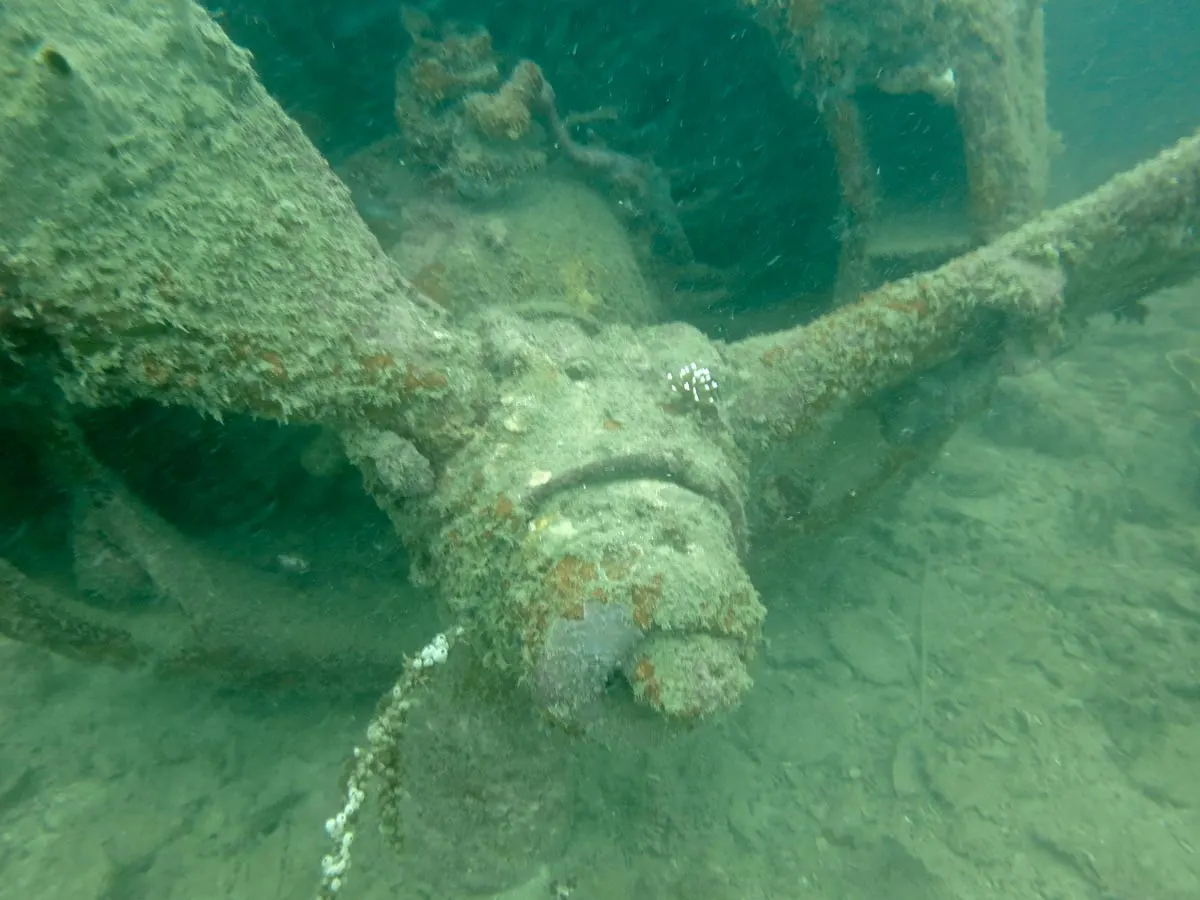
Diving from Una Una – nice diving, more than 30 dive sites covered in massive fans and beautiful coral with marine life ranging from pelagic species like rays and reef sharks, huge schools of fish, barracudas, jackfish to nice macro diving with frogfishes, seahorses, leafy scorpionfishes and a variety of nudibranchs.
I had a great time here, but it takes time and effort to get to the Togean islands. Traveling only for Scuba diving, I would rather go to Lembeh, Komodo, or Raja Ampat with more impressive reefs, fish life, and macro diving. See our guide to the best diving in Indonesia
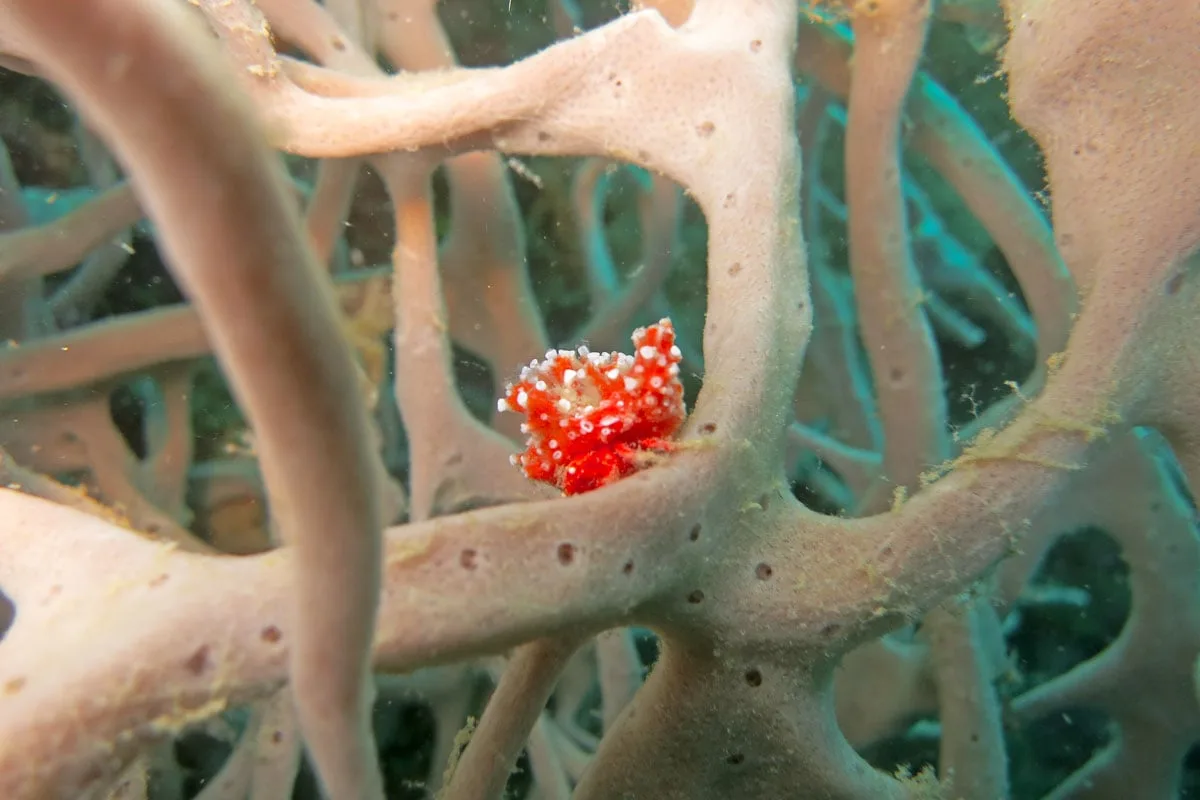
Dive Season in the Togian Islands
The Togian Islands can be dived all year round, but March to December is seen as the best time to dive here. This is the dry season making diving more pleasant, but visibility and conditions are good for diving all seasons.
Liveaboard diving around the Togian Islands
The Togian Islands are difficult to access and the perfect spot for an off-the-grid liveaboard experience. Four popular liveaboards operate around the Togians.
The Sunshine
KLM Sunshine is a 30m intimate, luxury liveaboard with double cabins equipped with private bathrooms. Operating around the pristine waters of Indonesia, home to a thriving ecosystem of over 600 species of coral and 3000 species of fish. Diving amenities include a spacious dive deck, rinse tanks, dive station, Nitrox, and dive guides.
- from US$ 179 / day
- Gourmet restaurant onboard, serving delicious meals
- a large sun deck with comfortable seating
- Check out the KLM Sunshine
Swim at Mariona Lake with the non-stinging jellyfish
Mariona Lake on Katupat, close to the main Togean island is one of 7 ‘jellyfish lakes’ in the world. The famous jellyfish lake in Palau was always on my bucket list, so I was super excited when I found out there was a similar lake in the Togians. In this rare lake, jellyfish lost the ability to sting over millions of years of geographic isolation. Swimming with thousands of harmless jellies was a beautiful and unreal experience. To get to Mariona Lake ask at your guest house for a boat contact, we were 3 friends who shared a local boat and it did not cost an arm and a leg. The existence of this specific jellyfish lake is not very well known, we were the only people posing for selfies with the awesome jellyfish when we were there. I have heard from dive centers that I corresponded with at the time of updating this post that there are currently a lot fewer jellyfish in the lake (2024).
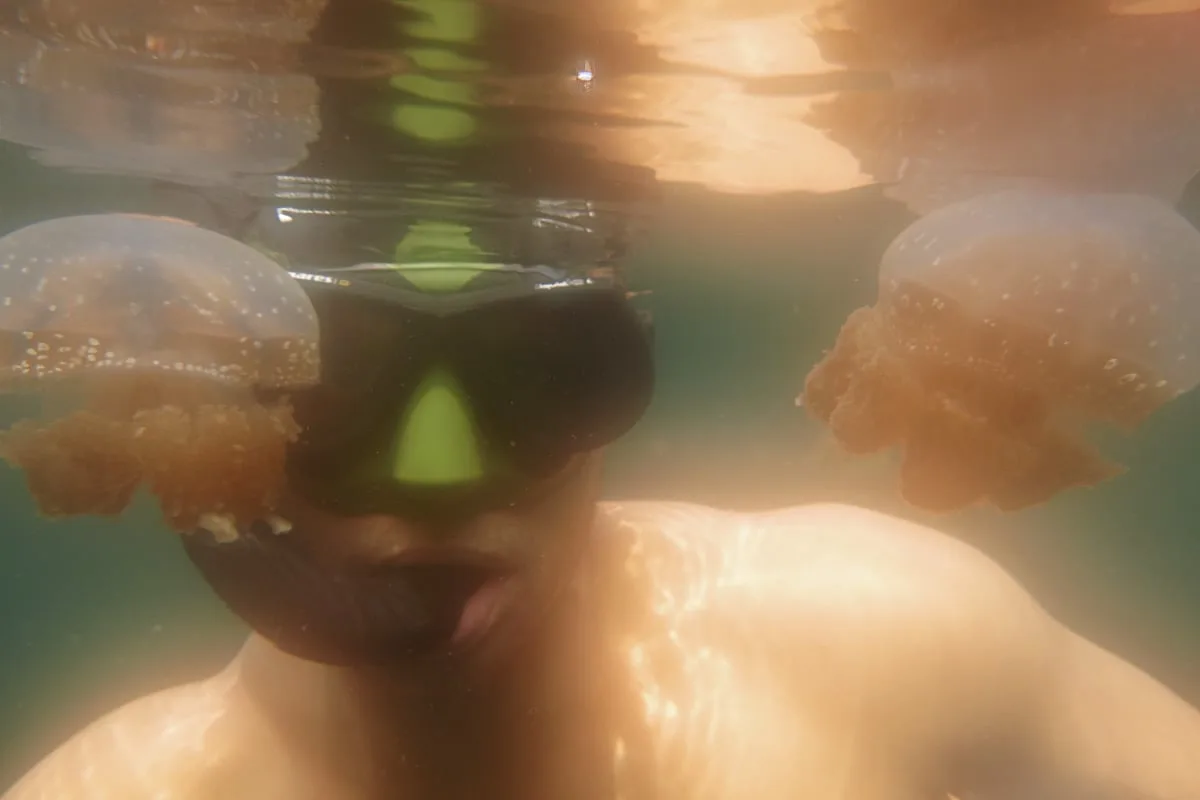
Staying with a local Bajo family
I have been fascinated by the Bajau people of Indonesia and the Philippines ever since watching the documentary Human Planet. The camera crew follows the lives of these Sea Gypsies living a nomadic life on the ocean. The documentary shows the amazing ability the Bajau spearfishermen have to hunt underwater with very primitive equipment and how fishing is done in these parts by compressor diving. We were privileged to stay in the Bajau settlement Pulao Papan in the Togean islands and have the opportunity to meet some of these unique people.
We paid a local boat owner at Kadidiri to take me and 2 friends to Pulao Papan where he spoke to some local people and organized for us to stay in one of the houses on the water with a local family. The town does not get many foreign visitors and the kids were fascinated by us, following us everywhere.
Some of the local fishermen were fishing by doing ‘compressor diving’. They dive with a surface supply of air coming from a compressor on a boat and lay out a huge net on the sea bottom, similar to how commercial divers work underwater. While diving they chase all the fish on the reef into the net and pull the net into the boat. This is a dangerous practice mainly because of the risk of decompression sickness and is very harmful to the reef and marine life.

Diving with the Bajau people “sea gypsies”
The Bajo people do free dive spearfishing so they do not use Scuba equipment, they do this without fins and some of them still use traditional equipment they make themselves, wooden goggles and homemade spearguns.
I do a lot of free-dive spearfishing at home in South Africa and was very excited to go spearfishing with an expert using these traditional methods.
I tried using the authentic Bajau goggles, a wooden frame fitted with a glass lens. It was difficult to see with the goggles leaking. I believe a lot of the Bajo divers use modern masks nowadays, they were, however, diving barefoot, and not using fins certainly makes it a lot harder to dive deep.
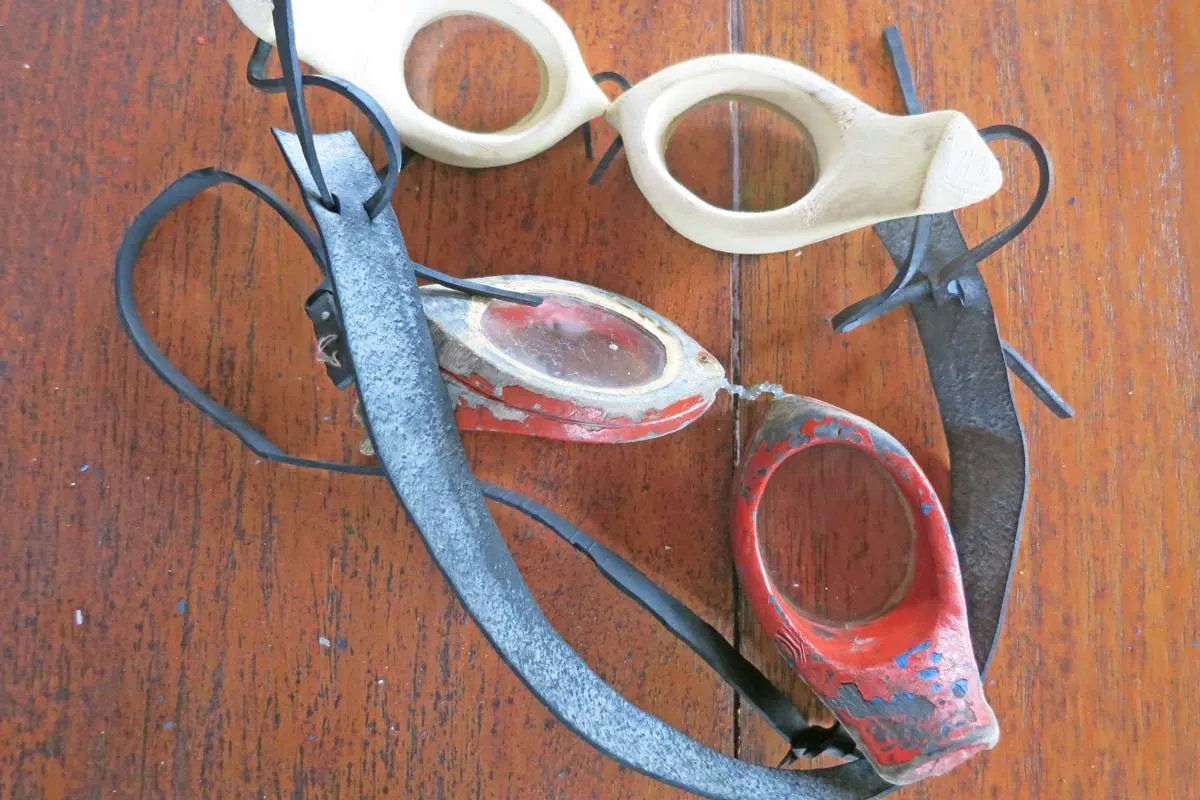
Wearing no fins with a gun in one hand made it difficult to dive deep. I managed to dive to 17m, but I could definitely not reach the depths Subin did in the documentary!
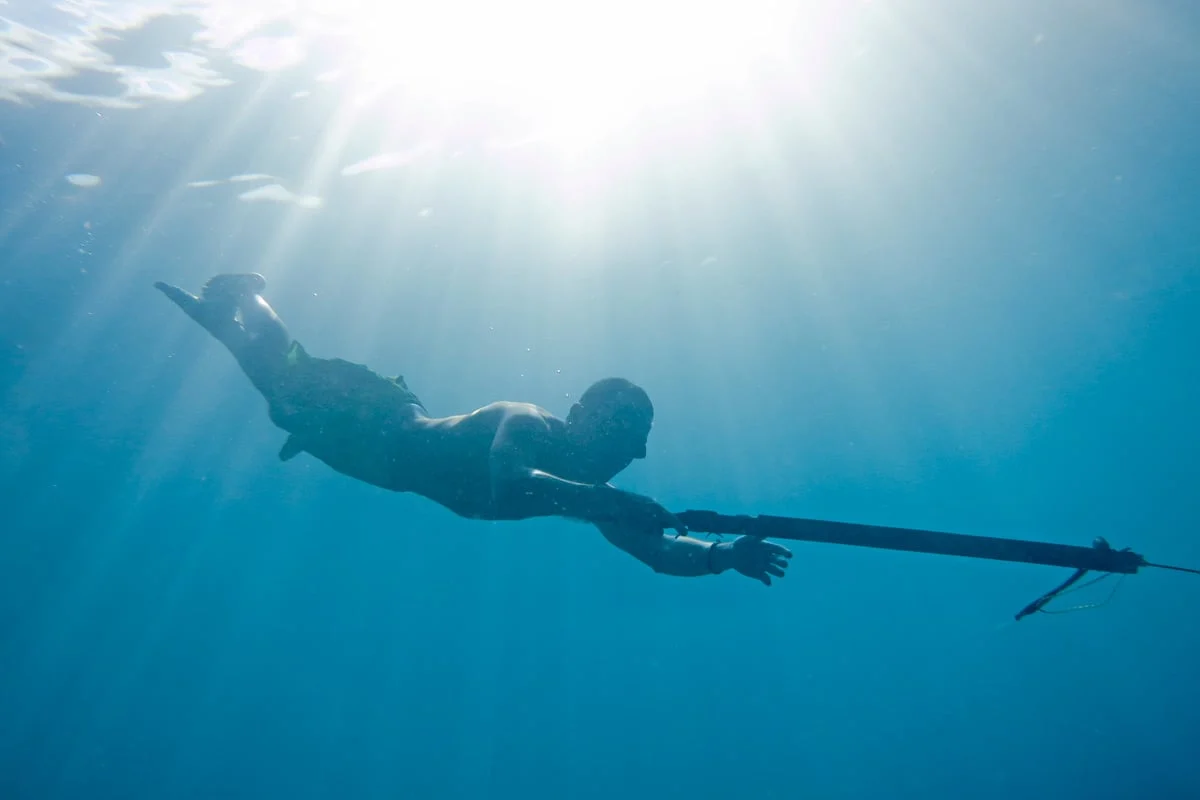
Diving with the local homemade guns, these spearos are limited to targeting smaller fish. The guns are just not strong enough to shoot bigger game fish.
The guns are powered by a couple of rubbers cut from car’s inner tubes. To increase the distance they can shoot, some of the guns are very big with barrels up to 2m long.
I believe spearfishing is a very selective and environmentally friendly way of fishing and did not shoot a lot of fish, since I was not keen to shoot small reef fish.

There was a couple of nice-sized blue fin trevally hunting in the shallows. These game fish were however very skittish when we got in the water. Approaching them with stealth was not very successful without wearing fins. We could thus never get close enough to spear them and the weak car tube-powered spearguns were not powerful enough to try to hunt these bigger fish.
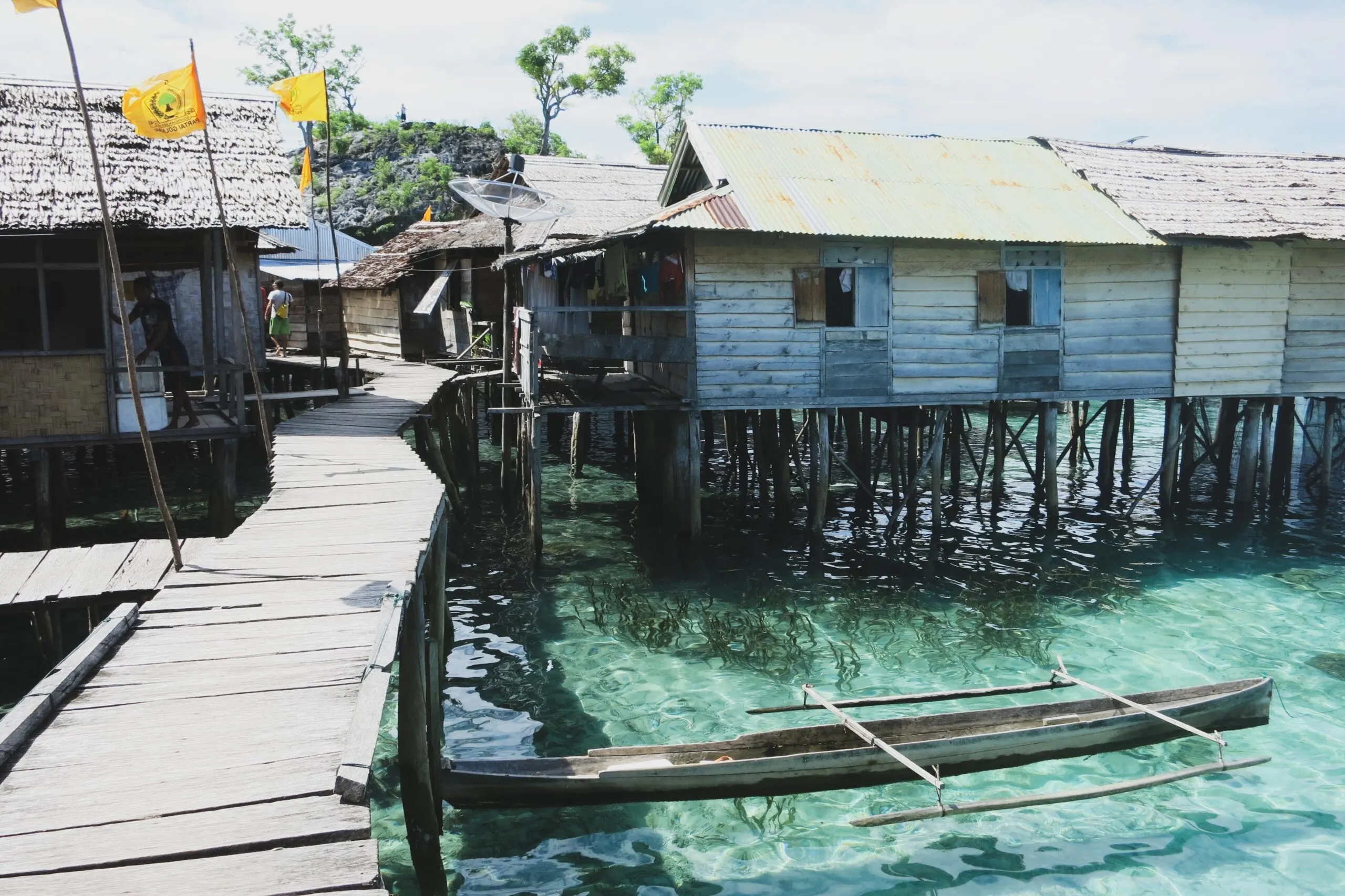
Mariona Lake and Pulao Papan were magic and are a bit of a mission to get to. Experiencing these places is definitely worth the effort if you travel to the north of Sulawesi.
Hike up at Una Una volcano
An awesome day hike through the beautiful jungle up the volcano and into the crater. Organize a guide at your lodge. Inside the crater you can go for a swim and see signs of volcanic activity; boiling water, steam, and sulfur. The hike takes about 5 hours.
More Sulawesi adventures!
- Heading North. – Funeral ceremonies, hanging graves, coffee farms, and a crazy bus chase in Tana Touraja.
- South Sulawesi. – Not well known as the north, but Pantai Bira has a lot of potential. We did some nice dives in the area.
- North Sulawesi. – Diving the famous walls of Bunaken and the magical creatures of Lembeh Strait. One look at our photos and you will understand why this place is a photographer’s dream!
Going to Bali? Check out our Complete Guide to Dive and Travel Bali
Going on a dive trip? – Dive Trip Packing List+Tips
More Diving in South East Asia
Sipadan in Malaysia and Komodo National Park in Indonesia are my two favorite areas to dive in the world. See in these articles why I love these dive spots.
Dive Nusa Penida near Bali is a great spot to mix a beach holiday or some surfing with diving. You can dive at this little island close to Bali with manta rays most of the year.
The Perhentian Islands in Malaysia are beautiful with crystal clear water and amazing beaches, this is also a great place to combine an island holiday with learning to dive. Koh Tao in Thailand is known as one of the best places in the world for any dive training, see our review of our favorite dive schools on Koh Tao.
Swimming with whale sharks is a bucket list experience for many who love the ocean, the Philippines has some fantastic areas for this experience. Check out our Whale Shark Swimming Guide for the Philippines and our thoughts on Swimming with Whale Sharks in Oslob.
Indonesia is not only about diving, check out 17 Awesome places in Indonesia our guide on How to get from Bali to Flores, and some activities and places not to miss in our Nusa Penida island guide.
We would love to hear from you, so don’t be shy to comment give suggestions or ask questions!
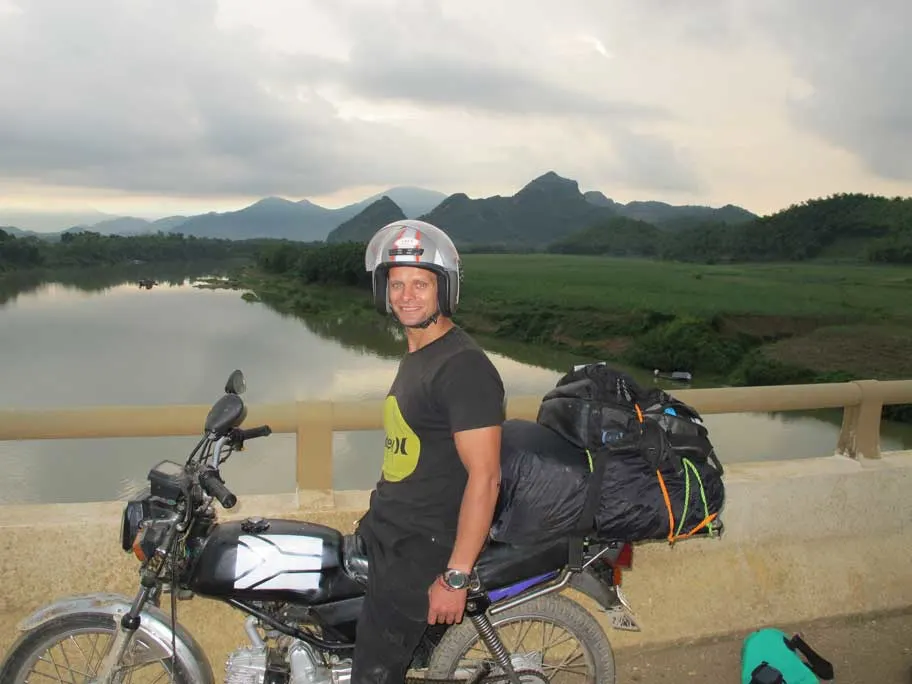
The strong half of Stingy Nomads, a nomadic aquaman that would be happy to spend all his life in the water diving, surfing and spearfishing but often has to compromise with Alya and go hiking instead. Campbell is responsible for all our marine adventures and following them with write-ups. He loves traveling, braai (BBQ in South Africa), red wine and spending the day in a wetsuit.


Andrew
Monday 10th of February 2025
Hi,
We have snorkelled and dived at Bunaken (stayed on Siladen Is) and Komodo (live aboard).
Keen to get your thoughts on Togian Is for snorkelling and diving against these two places.
Large fish in Komodo along with variety of unusual fish was very good. Walls at bunaken were fantastic and volume and variety of smaller fish was incredible.
Coral levels at both were great.
Can we expect the same or better in the Togian Island. Ie large fish, variety of fish and coral levels. Thxs
Stingy Nomads
Monday 10th of February 2025
Hello Andrew, thanks for reading. The I only did a handful of dives in the Togian Islands. It was nice with massive sponges, some fish life, nudi´s, beautiful coral reef and great visibility. The dives that I did around the Togians were not nearly as good as the coral reef on the wall dives in Bunaken or the fish life of Komodo. The Togians is an adventure, but if you are traveling for diving there are better spots in South East Asia.
Ruth
Friday 23rd of August 2024
Hiya, I'm so undecided on location and leave in a few weeks so would really appreciate your insight! I'm tossing up between Pulau Weh and Togean Islands (Kadidiri). I'm mid 30's and want to turn off everything electronic for a few weeks, just read / daily snorkelling with few dives / sunbake / walking trails/exploring (not super high priority). I'll be on my own, so it's nice if there's a few ppl around so not completely isolated. I know in Weh I can only wear bikini in a few spots which is fine, and Togean is a bit of effort to get to (but not much more than Weh as direct flight to Gorontalo from Jakarta). But I can't decide!! Does one have a better house reef to go snorkelling, or one have an overall better guest vibe etc. Appreciate any assistance as after reading about both on your site I'm 🤷🏼♀️. Thank you!
Stingy Nomads
Sunday 25th of August 2024
Hello Ruth, thanks for reading. My experience on both these spots were that it is a hit or miss. It is isolated spots and other guests or staff at your hotel can make or break your trip. I would rather have gone to one of the small Gili islands, Gili Air is much easier to travel to with more western facilities accessible if you want it and it has a better tropical island vibe. Also close to Bali Nusa Penida and Nusa Lembonghan is worth looking at and not touristy if you don´t hang out at the most touristy hotels. If you want to get more of the beaten track Bunaken in Sulawesi is nice, hanging out in your own little bungalow with a hammock at your front door and some of the best snorkeling/freediving you can imagine walking from your room.
Nicole
Sunday 12th of May 2024
Hi
Thank you for your helpful guide. How many days would you recommend staying in Togean Islands?
Thank you!
Stingy Nomads
Thursday 16th of May 2024
Hello Nicole, thanks for reading. That depends on what you want to do and what time of the year you are going and if you are traveling alone. You will need more time if you are going to stay on several islands and if you are a keen diver, this is the main activity most people go for. Since it is a mission to get there I would not go for less than 4 or 5 nights. More than a week gets long since it is isolated with most accommodation being basic homestays. Facilities and variety of food are limited. Enjoy and Safe travels!
Blanca
Saturday 2nd of March 2024
Thank you so much for this amazing blog! Has helped us so much! We will be there beginning of April and will let you know all about it!
Stingy Nomads
Monday 4th of March 2024
Hello Blanca, thanks for reading. Safe travels!
Adit
Sunday 17th of June 2018
Hello Stingy Nomads, nice story..
Plan to visit Togean on July.
I am a spearo and I wonder whether spearfishing is allowable at the area, especially when i stayed on one of the diving resorts having my spearfishing equipment, which commonly banned spearfishing.
It will be very helpfull of you could advise the skipper's name and his mobile, as well as Bajau's spearo at Pulau Papan so i can manage to met the them for a spearfishing trip.
Thanks